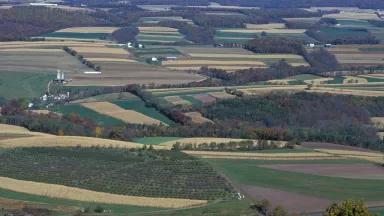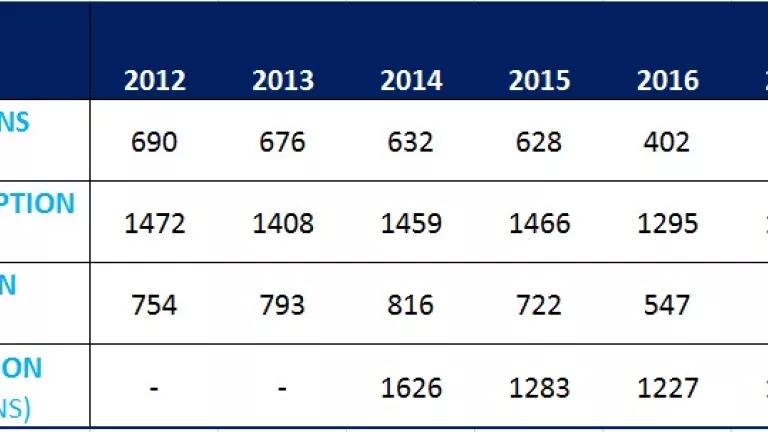A New ERA of Clean Energy for Rural America
USDA pioneers the largest investment in rural electricity since the Great Depression.

Solar panels, wind turbines and grain storage bins on a farm in Palms, Michigan.
Stanley E Rohrer/iStock
An unparalleled commitment to rural electrification, not seen in nearly 90 years, is underway, courtesy of the Inflation Reduction Act (IRA). Earlier this month, the Biden administration established guidelines for the Empowering Rural America (New ERA) program, a $9.7 billion financial assistance program for rural electric cooperatives (co-ops) to build clean energy systems. Despite the many benefits to rural communities, from job creation to reduced energy costs for consumers, threats are already emerging through extreme congressional proposals that would gut the program.
The launch of New ERA marks a pivotal moment in our nation’s energy history, paving the way for rural America to transition to a clean energy economy and achieve our goal of 100 percent clean energy by 2035. However, work still remains to implement the program and protect it from extreme congressional proposals.
Launching the New ERA program
Earlier this month, the Biden administration outlined the pre-application process for co-ops to start generating ideas and proposals to take advantage of the New ERA program. Co-ops can receive 25 percent of project costs to pursue solar, wind, hydroelectric, and nuclear systems, as well as the accompanying transmission infrastructure to bring electricity from the source to the consumer. Co-ops can also pursue carbon capture and storage systems if those systems can permanently store carbon dioxide and don’t lead to an increase in other air pollutants.
Importantly, the New ERA program can help co-ops get costly fossil-related debt off their books. Instead of saddling ratepayers with the debt associated with outdated fossil infrastructure, New ERA allows co-ops to refinance loans for retiring nonrenewable energy assets on an accelerated basis, with savings being reinvested into clean energy investments. Not only will this help relieve ratepayers from costly stranded assets but it will also provide an off-ramp toward more affordable and cleaner energy sources.
While the U.S. Department of Agriculture (USDA) is remaining flexible with the program and letting co-ops apply for the technologies and systems that work best for them, the USDA is clear about the goals of the program: reduction in greenhouse gas emissions, reliability and resiliency of power, and affordability to the consumer. And this model has drawn high praise from co-ops.
The National Rural Electric Cooperative Association (NRECA), the national trade association representing nearly 900 co-ops, applauded the USDA announcement. “This is an exciting and transformative opportunity for co-ops and their local communities, particularly as we look toward a future that depends on electricity to power more of the economy,” NRECA CEO Jim Matheson says. This sentiment is echoed by leaders and organizations across the country who also expressed praise for the announcement.
And the benefits to rural America could be immense. Rural economies could surge, with BlueGreen Alliance estimating that the New ERA alone can create 90,000 clean energy jobs as well as spark economic development in these same areas. If wind and solar projects replaced existing coal facilities owned by co-ops, RMI found that this could generate up to $50 billion in revenues to rural communities over the lifetime of these projects while paving the way for the decarbonization of buildings, transportation, and industrial processes.
What comes next? In August, the USDA will begin accepting letters of interest, which are preliminary applications where co-ops express what they could do with a New ERA grant or loan. Then, the USDA will pick the most ambitious projects that reduce or avoid greenhouse gas emissions while keeping rates affordable for ratepayers and invite those co-ops to submit formal applications in the fall of this year. In late December or early 2024, the USDA will then announce the recipients of New ERA funding and co-ops will get to work investing in rural communities and building these clean energy systems.
Powering rural America
Rural communities have long grappled with difficulties in affordably gaining access to electricity. In the 1930s, when most cities and towns in the United States had access to electricity, rural America remained in the dark—only 10 percent of rural America was electrified in 1932. Private utility companies were hesitant to invest in electrifying rural America due to concerns about the cost and return on investment. Without private utilities offering access to electricity, farmer-owned co-ops stepped in to collectively power rural America, creating the electric cooperative system.
Unlike a traditional for-profit electrical utility corporation owned by investors, co-ops are electricity-generating, -transmitting, and -distributing entities owned and guided by consumers. Importantly, co-ops are nonprofits, meaning they operate at cost and must accumulate equity capital to support new projects. If a co-op operates under a net profit, co-ops can return that money back to consumers in the form of a bill credit or check. However, these consumers are also responsible for the debt associated with existing investments.
The importance of co-ops in powering rural America cannot be understated. Today, co-ops serve 42 million people and 21 million schools, businesses, homes, and farms. More than 900 individual co-ops serve electricity to 47 states, with Connecticut, Massachusetts, and Rhode Island being the only states without a co-op presence. Co-ops also provide power to some of the poorest areas of our country, including 92 percent of persistent-poverty counties, or counties with a poverty rate of more than 20 percent consistently measured across 30 years. In addition to the power they provide, co-ops are also a driving economic force that’s directly responsible for more than 168,000 jobs.
For all of their benefits, co-ops have a problem: Their reliance on dirty energy contributes to our climate crisis, generates toxic emissions, and puts consumers at risk of rising prices and a less resilient grid.
Emissions and environmental justice
While each co-op is different, most co-ops rely on a fuel mix made up of primarily fossil fuels to provide power to their consumers, with more than 61 percent of the total fuel mix in 2021 consisting of coal, gas, or oil. Coal makes up a disproportionate amount of this fuel mix, accounting for 32 percent of the total fuel mix (compare that with the rest of the United States at 19.5 percent). Altogether, co-ops own, in whole or in part, nearly 90 coal-powered generating units capable of producing 23 gigawatts (GW) of power, equivalent to powering 2.3 billion LED lamps. Despite coal being one of the most detrimental fuel sources because of the pollution it releases into our air and our waterways—such as mercury, toxic metals, and more—co-ops continue to rely on coal-generating units as a fundamental source of electricity.
The communities and individuals that are on the frontline of this pollution are the coal-producing communities themselves and the communities where coal is burned. Coal communities and the individuals within them suffer from health impacts like black lung disease and potential environmental degradation of nearby water sources. The communities where the coal is burned, typically low-income and/or communities of color, face the brunt of the health-related impacts from air pollution, with air pollution from coal plants being linked to asthma, cancer, and other lung-related issues.
Rural areas of the United States also face another energy hurdle: energy burden. The energy burden—or the percentage of a household’s income spent on home energy bills for needs such as air-conditioning, heating, lighting, and more—is higher for rural communities when compared to the national average. A 2018 report by the American Council for an Energy-Efficient Economy found that rural America has a 33 percent higher energy burden than the rest of the nation. The energy burden for low-income rural areas is exacerbated even more, with those individuals paying nearly three times more in income than their higher-income counterparts. There is a need for clean and affordable energy systems, and rural cooperatives are uniquely positioned to provide exactly that, with the assistance of New ERA.
Co-ops not only provide power to residential consumers: 26 percent of the energy sold by co-ops goes to industrial uses. Access to clean, affordable energy is necessary to support emissions reductions from industrial facilities, which can be a key source of good jobs in rural areas. Electricity is used in multiple industrial subsectors, such as aluminum, steel, and other fabricated metals manufacturing as well as in the food industry, which consumes large amounts of electricity, predominantly for process cooling and refrigeration. Powering these processes with fossil-free energy will be critical for decarbonizing the industrial sector.
In addition to the health and environmental justice benefits, transitioning to a fossil-free electricity sector is essential to avoid the catastrophic impacts of climate change. For our agricultural sector, not addressing climate change will create unpredictable growing seasons, with increasing droughts and extreme weather events; changes in the pathogens, pests, and invasive species that impact our crops; and degrading soil health. Elsewhere, the unmitigated impacts of climate change will put our communities at risk of sea level rise, community displacement, and the collapse of wildlife species.
The longer electric co-ops wait to transition away from fossil-burning facilities to clean energy systems, the more detrimental impacts these facilities will continue to have on our climate and the health of our environment and communities. The rising costs to keep these facilities operational while complying with necessary pollution and health safeguards will be passed down to consumers and ratepayers, potentially increasing rates and worsening energy affordability.
Reliability in a changing environment
On the whole, we must significantly ramp up the deployment of clean energy in order to meet our climate goals. In rural America, this is no different. As fossil-dependent technologies become outdated and electric alternatives take their place, the overall demand for electricity is set to increase. The electrical grid across America will need significant upgrades to handle this increase and provide reliable power so that, when we flip a light switch, we don’t have to worry about whether the lights will come on.
Rolling blackouts and power outages during extreme weather events are already not uncommon. In December 2022, when a large portion of the country was dealing with extreme cold weather, power plants began to fail, on a scale large enough to power the entire state of California. Most of the plants that failed were powered by fossil fuels, including gas plants.
As demand for electricity continues to increase, and in the face of increased extreme weather events, grid reliability will be crucial. Luckily, clean energy and energy storage can help mitigate the worsening impacts of climate change while providing certainty that the lights will come on. With this in mind, the USDA ensures that New ERA will not risk grid reliability—allowing not only clean energy projects to be funded but also associated storage capabilities and their transmission.
Threats to our clean energy future
Unfortunately, even as the pre-application period is being announced, the New ERA program is not a guarantee just yet. Despite the support of more than 300 industry groups, environmental nonprofits, and other stakeholders, including NRDC, the New ERA program is at risk of being rescinded or diverted away from its intended purpose as members of Congress negotiate over other pieces of legislation, like the Farm Bill and government funding. Any legislation that rescinds or reshuffles programs within the Inflation Reduction Act should be seen as a nonstarter, as doing so would put the clean energy economy in jeopardy.
Moreover, Speaker Kevin McCarthy’s “Default on America Act” passed the House of Representatives just last month, despite bipartisan opposition. The legislation would eviscerate clean energy tax credits that rural electric co-ops could take advantage of to build low-cost clean energy systems, meaning ratepayers may have to shoulder the burden of that extra cost. While New ERA would cover 25 percent of the total project cost, the clean energy tax credits would make it even more affordable and attainable to build large clean energy systems, covering 30 to 50 percent of the remaining cost. Since ratepayers are responsible for the debt and profits of the co-ops themselves, Speaker McCarthy’s Default on America Act may raise the overall cost of clean energy systems and pass this cost to the ratepayers.
Over a hundred years ago, rural America was left behind in the race to electrify the country, and when they were, rural electric cooperatives helped power our rural communities. Now, these same co-ops can make sure rural America does not get left behind again—this time, in the race to provide clean, reliable, and affordable energy.







